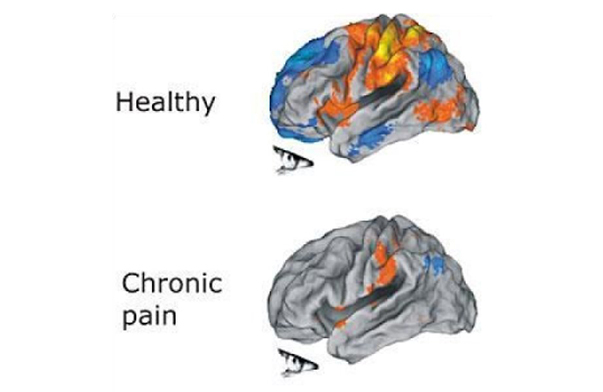Spine surgery and changing concepts in pain
Comparison of brains. These images show the brain from the left side, demonstrating striking differences between chronic pain patients and healthy subjects. They illustrate with colors how much activation (red-yellow) or deactivation (dark/light blue) was found at each location.
show the brain from the left side, demonstrating striking differences between chronic pain patients and healthy subjects. They illustrate with colors how much activation (red-yellow) or deactivation (dark/light blue) was found at each location.
Credit: Image courtesy of Northwestern University
As spine surgeons we often try to help people with pain it is very important to have understanding of concepts of central sensitization and wind-up to better understand pain of our patients.
We often encounter patients with allodynia- where the pain perception is out of proportion to the stimulus applied. The pain response is often perceived as abnormal and patient is often considered to have lot of functional overlay. These patients are not considered as good candidates for any interventional treatment and are often subjected to purposeful neglect. Some of these patients even doubt themselves as being crazy.
Understanding of central sensitization is critical to understand why these patients are having this abnormal response. To put it simply – human brain gets sensitized to a stimulus- if the pain is persistent. The new wirings in the brain create new neuronal memory and circuits which amplify the perception of the pain with a repeat stimuli and cause perception of pain even for normal stimuli like touch.
Understanding of central sensitization is critical to understand why these patients are having this abnormal response. To put it simply – human brain gets sensitized to a stimulus- if the pain is persistent. The new wirings in the brain create new neuronal memory and circuits which amplify the perception of the pain with a repeat stimuli and cause perception of pain even for normal stimuli like touch.
These are the patients who manifest with persistent pain even after spine surgery. These patients need more understanding and care from our side. Presence of central sensitization can be approximately established by presence of tactile allodynia, hyperalgesia, increase of receptive fields and sensory after effects.
These sensitizations can be prevented by preemptive analgesia, with Cox 2 inhibitors, local blocks Gabapentin and Opioids given before and during surgery rather giving them after surgery. NMDA receptor antagonists like Ketamine and dextromethorphan have been proved to prevent central sensitizations. This multimodal approach has been quite successful in prevention of postoperative pain syndromes and early discharges in day care settings.
Patients with established allodynia may need further constructive collaboration other disciplines and require, cognitive behavioral therapy, antidepressants, antiepileptics (gabapentin) along with medications like anti- inflammatories in patients with inflammation. Opioids may not help. Patients are known to have benefits with anxiety relief, meditation, yoga and most light aerobic exercises.
These patients are to be treated differently and with utmost compassion as they are vulnerably to more anxiety and frustrations. Understanding Central sensitization enable spine physicians to understand patients’ pain better and treat them better. New treatment modalities based on the understanding of central sensitization targeted at the newer areas are on the horizon.
Dr Amit Bhandarkar MD

